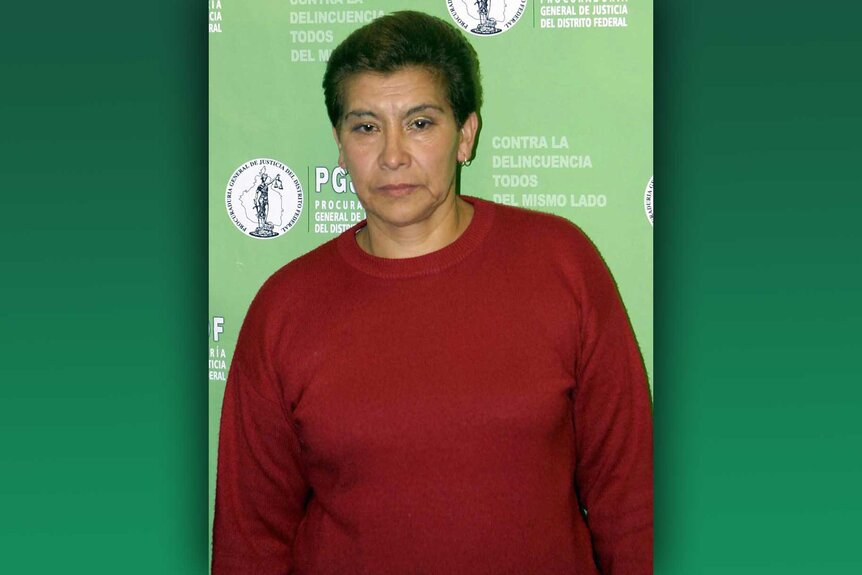Create a free profile to get unlimited access to exclusive videos, breaking news, sweepstakes, and more!
How Mexican Serial Killer "La Dama del Silencio" Juana Barraza Eluded Capture
Learn more about a string of murders in Mexico, known as the La Mataviejitas killings.

Before Juana Barraza embarked on her killing spree, Mexican officials had not acknowledged the existence of serial killers. But that all changed in 2002, when elderly woman were increasingly found to be murdered in their Mexico City homes.
Though Mexico City's homicide rates have decreased in recent years, according to Mexico News Daily, there was never more urgency to find a killer than there was in the early aughts, when dozens of elderly women were killed. As Susana Vargas Cervantes wrote in The Little Old Lady Killer: The Sensationalized Crimes of Mexico's First Female Serial Killer: "It was perceived by both authorities and the media as worse than other types of murder cases — not because of the number of victims or the manner in which they were killed, but because of who they were: elderly women."
RELATED: Police Analyzing "Items" Found At Portuguese Dam in Search for Madeleine McCann
After all, these women were grandmothers and beloved figures in their communities. The question on everyone's mind was: How could someone do such a thing?
It was only after the police apprehended the killer, a luchadora, that they understood what drove someone to murder the elderly. Keep reading to find out more about La Mataviejitas, "The Little Old Lady Killer."
Who is La Mataviejitas Juana Barazza?
Juana Barraza's transformation into La Mataviejitas started in her early childhood.
Born to Justa Samperio and Trinidad Barraza on December 27, 1957, Juana had a troubled childhood. Her mother was only 13 when she was born and her father was not in the picture, often leaving Justa for long stretches because of his work as a truck driver, according to an El Universal article translated from Spanish. Eventually, Justa grew tired of waiting around and left Trinidad, taking Juana with her when she was only a few months old.
RELATED: Minnesota Teen Mysteriously Disappears after Partying with Friends — What Happened to Her?
Juana alleged that her mom later "gave her away" when she was only 13 years old to a man who held her captive and raped her, according to Cervantes' The Little Old Lady Killer. And while Juana hoped her mother would save her, Justa never returned and Juana spent five more years with her captor, giving birth to her first son with the man.
Her mother's abandonment during her teen years would later become Juana's justification for the murders, with the serial killer telling investigators, " I hated old women because my mom mistreated me. She always cursed me. She gave me away to an old man and I was abused," according to a 2016 video from Azteca Noticias.
Though Trinidad had not seen Justa or Juana in years, he told El Universal that he never knew Juana's mother to be an alcoholic. "While she was in my power, no, she didn't drink, she wasn't vicious," he said.
Juana's eldest son later died, reportedly beaten to death with a baseball bat by muggers, according to The Guardian. She had three other children, whom she raised as a single mother.
"She is proud of being both a father and mother to her children," her lawyer once said, per The Guardian.
La Dama del Silencio
Later in life Juana became a luchadora, donning a pink mask and jumping in the ring as La Dama del Silencio, which translates to The Lady of Silence. When asked about her name by police in later interviews, she reportedly told them she chose it "because I am quiet and keep to myself," according to The Guardian.
She was considered a "ruda" wrestler, meaning she wasn't professionally trained. Coincidentally, while police were searching for La Mataviejitas, Juana participated in an interview with TV Azteca. The interviewer asked her about her fighting style, to which Juana smiled and said, "Ruda to my core."
When she wasn't wrestling in the amateur circuit, Juana sold popcorn.
La Mataviejitas' Victims
Authorities believe La Mataviejitas' first victim was María de la Luz González Anaya, 64, who was found beaten and strangled in her Coyoacán, Mexico City, home on November 25, 2002.
She killed her second known victim, 84-year-old Guillermina León, four months later. After those first kills, police said that she went on to murder as many as 46 women, according to La Vanguardia.
Juana later admitted to police that she had dressed as a nurse or social worker and befriended her victims before gaining entrance to their homes. She strangled them with her stockings, phone cables or other items, the Guardian reported. She mostly left behind valuables, though the news outlet reported that she would sometimes take "images of saints, crucifixes, and bibles."
As Juana's victim count increased, police interviewed witnesses who saw the killer with the victims in the hours before their deaths. They described the killer as being a man with short blonde hair. Cervantes wrote in The Little Old Lady Killer that the sketches said more about Mexican beliefs and prejudices than it did the suspect. "The use of sketches in the Mataviejitas case is problematic because of the way they perpetuated the masculinization of criminality, especially with regard to serial killing," Cervantes wrote.
As a result of this widely held belief that men are more likely to murder, the police erred in their search, the BBC reported. "So they went in October of 2005 and arrested many transvestite sex workers and and after none of them matched their fingerprints, they concluded, OK, it's not a transvestite, but we're sure it's a transgender person," Cervantes told Inside Edition in 2019.
The investigators were no closer to catching the killer.
How Was Juana Barraza Caught?
Police finally got the break they needed on January 25, 2006, when Juana was leaving the home of Ana María de los Reyes Alfaro, 84, who she had stabbed and strangled. The Guardian reported that Alfaro's tenant saw Barraza leave the home moments before he found the body and chased her. Neighbors, and a police officer stopped the then-48-year-old as she tried to escape.
According to The Guardian, Juana had a list of names and addresses of elderly women, a stethoscope and a fake social worker ID in her possession at the time of her arrest.
When the press asked her about her crimes, she said, according to The Guardian, "I know it's a crime, I did it and I will pay for it. But just because I'm going to pay for it, that doesn't mean they're going to hang all the other crimes on me. ... With all due respect to the authorities there are several of us involved in extortion and killing people, so why don't the police go after the others too?"
Prosecutors said that 10 fingerprints taken from the crime scenes matched Juana, but she continued to deny involvement in the killings.
"I only killed one little old lady. Not the others," she said during her trial, according to The Guardian. "It isn't right to pin the others on me."
She was sentenced to 759 years in prison for the deaths of 11 elderly women in April 2008.
Where Is Juana Barraza Now?
Juana Barraza is incarcerated at the Santa Martha de Acatitla prison in Mexico City, according to El País. From Monday to Wednesday, she makes tacos, which she sells in the prison courtyard.
For a brief time, she was married to another convict, 74-year-old Miguel Ángel, who was housed in the men's unit of Santa Martha de Acatitla, El País reported in 2015. Ángel reportedly won over Barraza's heart through a series of letters for about a year, after which they wed alongside 48 other prisoners. Described by the Spanish outlet as a "collective ceremony," the couple was able to partake in a reception that included music, food and, of course, cake.
Their marriage was made possible thanks to the government program Lazos en Reclusíon, which translates to bond in confinement.
However, the pair went their separate ways after a year. Turns out Barraza had spent less than an hour total with her husband, whom she quickly fell out of love with. "Once we saw each other, the love vanished,” Barraza told a deputy, according to El País.


























